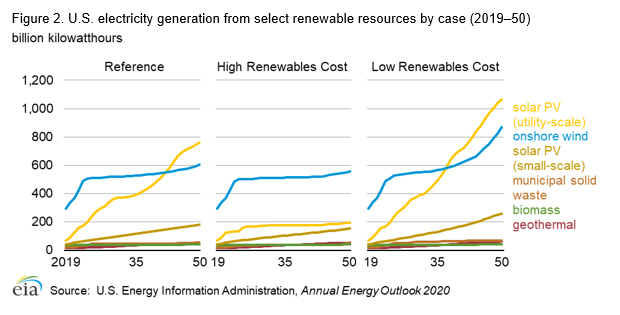- Reference Case: Geothermal grows from 16.43 billion kilowatthours (BkWh) in 2019 to 52.17 BkWh in 2050.
- Low Renewables Cost Case: Geothermal grows from 16.43 BkWh in 2019 to 62.84 BkWh in 2050.
- High Renewable Cost Case: Geothermal grows from 16.43 BkWh in 2019 to 53.41 BkWh in 2050.
In the Low Renewables Cost case, utility-scale solar PV is more competitive compared with natural gas-fired generation capacity to meet growing demand. When solar PV is no longer economically competitive, as in the High Renewables Cost case, natural gas-fired generation capacity replaces it as the more cost-competitive generating technology to meet demand. Wind plants generate mostly at night or during the fall and spring when the demand for electricity is typically low; therefore, onshore wind is less affected by the changes in the cost assumptions than solar PV.
In the High Renewable Cost case, which assumes constant installed costs, generation from wind is slightly less in 2050 than in the Reference case. In the Low Renewables Cost case, wind generation increases at a more rapid pace after 2035. While the PTC is phasing-out, through 2023, wind is highly cost-competitive. Wind projects are accelerated in the near term to take advantage of tax credits before they expire. Once expired, the most economically attractive projects absent the tax credit have already been built, at least until electricity demand and economic conditions create new opportunities after 2035.
Read More..........
